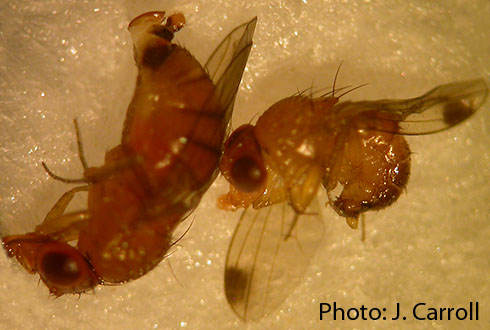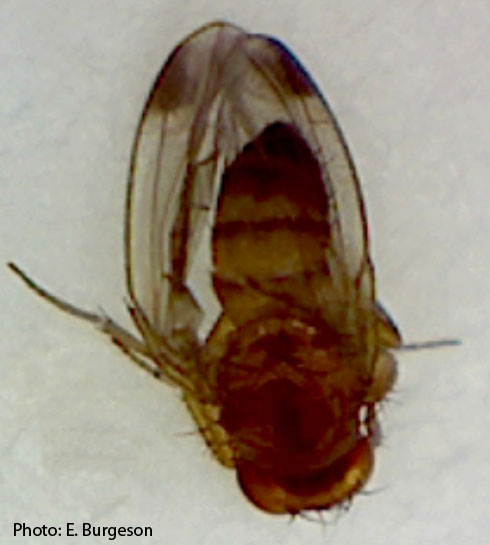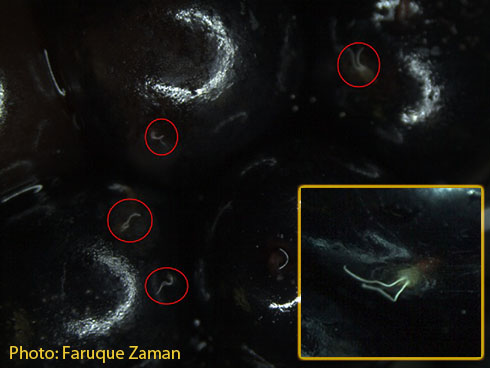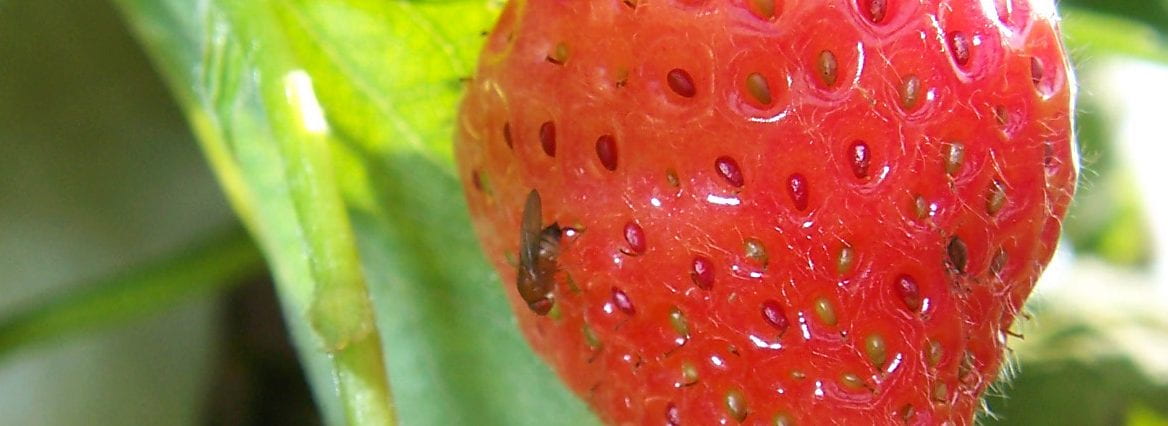SWD were caught in traps collected on August 26 from two raspberry plantings in Herkimer County by Bernard Armata, Herkimer County Cornell Cooperative Extension. At one location, 5 male and 3 female SWD were caught in the planting and 3 male and 1 female outside the planting. At the other location, 2 male SWD were caught in the planting and none outside the planting. A third location in Herkimer County has not yet caught SWD. All the plantings being monitored in Herkimer County are small, isolated locations. (Accumulated GDD 1888, day length 13:23)
Black cherry hosts SWD
The forest and woodland tree, black cherry, Prunus serotina, is another SWD-preferred wild host. This tree grows in forests and landscapes throughout the Northeast and is native to North America. On Long Island, recent inspections by Faruque Zaman, Suffolk County Cornell Cooperative Extension, showed that over 90% of its fruit were infested with SWD. On average, 112 adult SWD emerged after incubating 4 oz. samples of black cherry fruit in the lab. So far, black cherry is the earliest (mid-July) wild host utilized by SWD that has been identified on Long Island. Pokeweed, another known wild host of SWD, has been found to have 80% infested fruit at this time. Fruit of these two wild hosts appear to be the most preferred in late summer and early fall. At this point, we have no clear idea what proportion of the SWD population is migrating into crops from these hosts nor whether SWD will overwinter from these wild hosts.
St. Lawrence County – first report
On August 19, a trap set in a black currant planting by Paul Hetzler, Cornell Cooperative Extension of St. Lawrence County, caught 3 male and 1 female SWD. The trap had only been out since August 17th. SWD damage in blueberries has been seen in St. Lawrence County, with approximately 40% damaged fruit found in one planting. Last year, at this date, the same blueberry planting had 100% fruit infestation. (Accumulated GDD 1632, day length 13:48)

Organic Workshop
On August 26, from 5:00 to 7:00 pm, at Westwind Orchard, 215 Lower Whitfield Rd., Accord, NY 12404, a workshop featuring organic management tactics for SWD will be held. Attend to learn about efficacy of organic-approved pesticides, use of exclusion netting, and key cultural practices to reduce SWD infestation of fruit. Registration fee is $10/person or $15/two or more people per farm. Preregistration deadline is 5 pm today, August 22! Contact the Registration Coordinator, Stephanie, by phone at 585-271-1979 ext. 509, or by email at register@nofany.org
Organized by Emily Cook, Organic Vegetable and Fruit Extension Educator, Cornell Cooperative Extension of Ulster County, the Organic Management of SWD Workshop is a collaboration between NOFA-NY and CCE of Ulster County with support from the USDA Risk Management Agency, Outreach and Assistance Program and the Local Economies Project of the New World Foundation.
Chautauqua County – first report
Two male SWD were caught on August 7 in traps set in a red raspberry planting in Chautauqua County by Virginia Carlberg and Elizabeth Burgeson, Chautauqua County Cornell Cooperative Extension. With this report, SWD has been found across New York State, from Suffolk County north to Clinton County, west to Niagara County, and south to Chautauqua County. Sustained trap catch has occurred in the Finger Lakes and Lake Ontario Plains. Fruit infestation is being reported in Long Island and the Hudson Valley. Management tactics for SWD are now critically important. (Accumulated GDD 1458, day length 14:07)

Monroe County – first report
A single male SWD was reared from black raspberry fruit collected from a farm in Monroe County on July 22, 2013 by Debbie Breth, Lake Ontario Fruit Program, Cornell Cooperative Extension. Traps collected this week are currently being processed, though traps set at this farm location have not yet caught SWD. Raspberries are very susceptible to SWD infestation. Oviposition can be identified, with a hand lens, magnifying glass, or microscope, by finding the tiny, white breathing tubes on the fruit surface that are attached to the eggs laid under the fruit skin.

Erie County – first report
A single female SWD was caught in a trap in Erie County by Sharon Bachman, Erie County Cornell Cooperative Extension, and confirmed by me, Juliet Carroll, NYS IPM Program. The trap was set near brambles. SWD is being consistently caught in traps in many locations in NY underlining the need to establish insecticide programs to protect late summer berry crops from infestation by this invasive fruit fly.

Orleans County – first report
Two male and one female SWD were caught in one out of four traps collected by yours truly on July 30 from a sweet cherry orchard in Orleans County. Traps near a raspberry high tunnel and in a blueberry plantation on the same farm did not have SWD in them. (Accumulated GDD 1475; day length 14:31)
Tioga County – first report
SWD were caught in traps collected on July 29 that were set in and near high tunnel raspberries in Tioga County by Kat Loeck, Tioga County Cornell Cooperative Extension, and identified today by yours truly. The finding of 16 females and one male underlines the need to take steps to protect berry crops from SWD infestation. (Accumulated GDD = 1336, day length = 14:29)
Niagara County – first report
A single male SWD was caught on July 30 in one of two traps set in a raspberry planting in Niagara County by Juliet Carroll, NYS IPM Program. Traps had been moved from an adjacent, renovated strawberry field to the raspberry planting last week. (Accumulated GDD 1273, day length 14:31)


